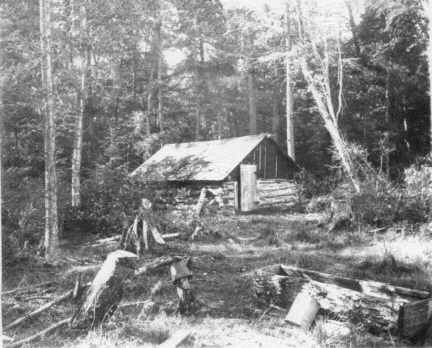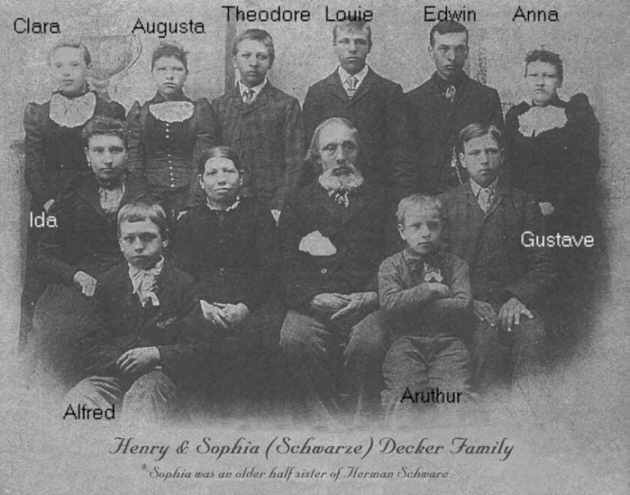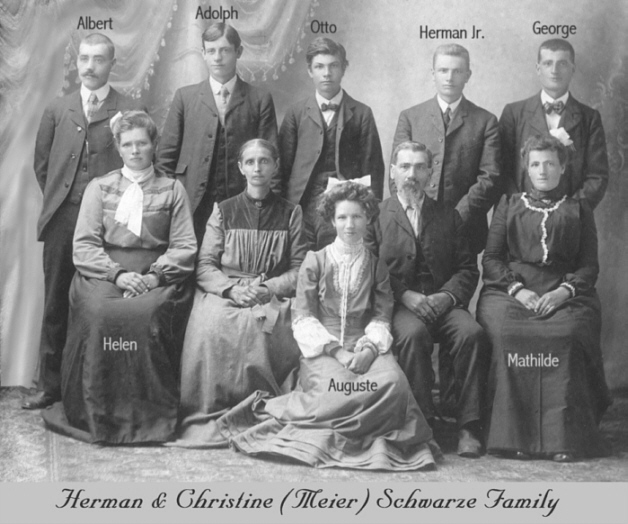THE LIPPE-DETMOLD COLONY OF WARNER TOWNSHIP,
WI

The Lippe-Detmold colony in Warner township,
Wisconsin began when the families of John and Mary
(Kremer) Vollrath, Henry and Sophie (Schwarze) Decker, and Henry
and Louise (Viole) Schwarze heard the call of the northland and
left Franklin, Sheboygan County to establish homesteads in the
timberlands of Clark County. Very few white men had ever brought
their families to live in this remote region of the United
States.
Some of the best hardwood in Wisconsin was found in Warner where a
dense vigorous growth of white and red oak, linden, maple, rock
elm, birch, ash and some butternut stood. These vast forests had
scarcely been touched by the woodsman's ax. The most universal of
the hardwoods were the linden or basswood, which constituted nearly
one-half of the hardwood suitable for lumber, and was found to be
excellent quality and very abundant. Next after this was oak, red
and white, which in about equal quantities constituted nearly
one-fourth of the whole amount. The most abundant, red oak was very
large and healthy, and was probably as good as can be found
anywhere in the Northwest.
These woodlands had originally been surveyed by United States
surveyors between 1842 and 1856 the section and quarter corners
were marked by a wood stake and from one to four (usually two)
trees were marked by a wood stake, and the kind, diameter,
direction and distance from the stake were noted. This survey was
hurriedly and carelessly done, but however imperfectly surveyed, or
however irregular, each new owner had to locate the boundaries
pertaining to the deed for the land they d purchased. It was not a
job for the weak. The tangled forest was infested with wild animals
and Winnebago Indians who understandably considered it their own
land. On June 1, 1870, the first adventurous German pioneers from
Sheboygan arrived on the west bank of the Black River very close to
where the United Church of Christ Church of Warner now stands (3
mi. west of Greenwood on county road G and 1 mi. north on co. rd.
O). All three families found shelter under the roof of an abandoned
log house and immediately began to clear a small area of land in
order to plant a life sustaining garden as quickly as possible
using the skills and tools they d brought with them. By fall, each
family had a small log home on their own property.
Once settled, periodic trips had to be made on foot to and from
Neillsville for supplies. Those who made the trek would often times
set up camp in the woods along the way and sometimes when they
returned, they were carrying a fifty-pound sack of flour on their
back. Years later, stories were told how the flour would sometimes
have to be hoisted about the neck as the transporter swam across
tumultuous currents because it was not always possible to cross the
river by boat.
John Vollrath, being 55 years old, was the senior member of the
budding community. His wife, Mary, would have her 52nd birthday
that August. They were the parents of three unmarried children
twenty-two year old Philip, nineteen year old Charlotte, and
thirteen year old William. They'd also had two other children who
died when very young. Mary didn't tolerate the harshness of those
first difficult years very well and she did not live to celebrate
Christmas in 1871. She did not live to see her children married or
to hold any of her grandchildren in her arms. Hers was the first
grave these close-knit neighbors had to prepare. She had been the
mother of the little community. Now, that distinction would be
passed on to Louise.
Henry and Louise Schwarze had embraced love and married in
Lippe-Detmold, Germany November 18, 1863, when he was twenty-five
and she was thirty. They immigrated as a family to the United
States in 1867 with three small children in tow: seven year old
Caroline Louise, two year old Henry William and six month old Fred.
In addition, Henry's twin half brothers, Herman and John
accompanied them. Their father had died when they were eight years
old. His second wife, their mother, died the following year and
their big brother Henry became their guardian. When they left
Germany with Henry and Louise, they were seventeen years old and
able to be a great help in the fields. Herman had already acquired
the skills of blacksmithing, taking up the skill of his father and
grandfather. The Schwarze family was so predominate in those early
years that people throughout the county referred to this
Lippe-Detmolder branch colony as The Schwarze Settlement. Later,
when they managed to cut roads through the dense growth which
enveloped them, the junction which bordered Henry's land was
called, Schwarze's Corner.
A second daughter, Bertha, had been born to Henry and Louise before
they left Franklin, Sheboygan County, Wisconsin and purchased their
land in Clark County. When they arrived in Warner, Louise was in
the first trimester of yet another pregnancy. Henry's twin brothers
didn't join them until later that summer.
Sophie Decker was the younger sister of Henry Schwarze and an older
half sister to the twins, Herman and John. She d married Henry
Decker, October 13, 1867 when she was 23 years old and he was
thirty-two. When they made the move to Clark County, less than
three years later, their little girl, Ida, was a year and a half
old and about to become the older child. To the joy of everyone,
her baby sister, Anna arrived with a vigorous, healthy cry just 6
weeks after the family setup housekeeping in that abandoned cabin
with their friends and relatives. Her birth gave new life to the
once deserted homestead. She would grow to womanhood with her big
sister and the cousins who snatched little peeks at her as she
snuggled in the soft blanket wrapped around her tiny form.
By 1871, Fred and Maria Meier Decker had joined the settlement
along with her younger sister, Christine who was destined to marry
Herman Schwarze a couple of years down the line.
In 1873 came Fred and Charlotte Schaper Buker, making the long,
hazardous journey from Sheboygan county with their team of horses,
making the journey overland by wagon to Neillsville and hauling
2,700 pounds in freight. December 1865, he had married Charlotte
Schaper, a native of Lippe-Detmold, Germany. She and their two
children, Fred and Edwin, came by train. George, another son, was
born in Clark County, and later resided on the homestead in Warner
Township. Fred Buker had located on a tract of land of 160 acres in
Section 24. The tract was covered with woods and Mr. Buker had to
cut his own road to the place. On the land stood an old log
building, but Mr. Buker soon erected a new one 26 by 28 feet in
size, and in the second year he built a barn of logs, 32 by 72
feet. There he and his family resided for two years. At the end of
that time he secured a 200-acre tract in Section 19, it being all
covered with woods and reached only by a trail. There was a log
house and barn on the place and part of one of the forty-acre
tracts of which it was composed had been cleared. To his land Mr.
Buker eventually added forty acres more, making it into a 280-acre
farm. With his own hands Mr. Buker cleared 130 acres of the farm in
eight years, and during those winters worked in the lumber woods.
He built a large house and barn, 44 by 120 feet, which latter,
however, burned down, with the loss of a bull and a quantity of
grain. To make good the loss of the barn he erected another,
measuring 44 by 100 feet, and also a silo, built by his son,
George. For many years Mr. Buker was one of the prominent citizens
of Warner Township, serving as chairman of its board for seven or
eight years, and for nine years as assessor. It was also he who
instituted the movement that resulted in the building of an iron
bridge across Black River. He helped to build the Reformed Church,
where he served as deacon and one of the most active workers. He
has also served efficiently as a member of the school board. His
wife, Charlotte (Schaper) Buker, died in 1909, at the age of 86
years. In addition to the children already mentioned, they had two
daughters born in Warner Township--Emelia, now Mr. H. Decker, Of
Warner Township and Bertha now Mrs. John Steiger.
In 1873 Ludwig and Charlotte (Strate) Noah and their family moved
in and in 1874, Henry Fravert joined the blossoming community.
Every year, more and more German families arrived from Sheboygan
until they permeated the countryside.
Henry S. Humke was born in Hermann Township, Sheboygan County,
Wisconsin, April 27, 1855, the son of Conrad Humke, a native of
Detmold, Prussia who emigrated to Sheboygan County. The family came
to the United States in 1842, and first lived in or near Buffalo,
New York, later moving to Cincinnati, Ohio, where he chopped wood
on the Ohio River several years. He subsequently settled in
Sheboygan County. Henry worked in the pineries eight winters, and
during that time was engaged in farming and also drove logs during
the springs and summers. He arrived in Clark county in 1878 and
settled on a farm of 120 acres, forty of which he cleared. When he
first settled there, it was covered with timber, with not even a
shanty on it, and the first year he lived in a small log house.
Novemeber 18, 1879, he married Anna KIPPENHAN, the daughter of Adam
and Helen (Richter) Kippenhan.
These early settlers shared their belongings as they worked
together to build homes, clear land and feed their families.
Together they picked the scrumptious abundance of wild berries and
hunted bear and deer to sustain themselves. They worshipped in
their log cabins, reading scriptures by candlelight and singing
German Hymns with devotion, all the while longing for an ordained
minister of the Reformed faith to deliver the word of God to them.
Their prayers were answered in 1873 when Rev. C. H. Schoepfle of
LaCrosse visited and conducted sermons in the German tongue at what
was then called the Decker School House (so called because Henry
had donated the acre of land where it was built).
Under the leadership of Rev. Schoepfle, a church was formed,
January 11, 1874. A meeting was called and a congregation organized
as Die Deutsch Reformierte Immanuels Germainda in Town of Warner,
Clark County, Wisconsin. Its founding members were: Henry Schwarze
and Louise, Frederick Buker and Charlotte, Henry Decker and Maria,
John Vollrath and Margaret, Philip Vollrath and Louisa, Ludwig Noah
and Charlotte, Adolph Noah and Mina, August Noah and Louisa, Herman
Schwarze and Christine, Gottlieb Meinholdt and Augustine, Carl
Meinholdt and Minna, Ernst Meinholdt, Henry Fravert and Margaretha,
Peter Brick and Elizabeth, Henry Humke and Anna, Henry Kern and
Johanna, Peter Miller and Elizabeth, John Schwarze, Heinrich Meier
and Amalia, Frederick Wehrmann and Marie, Henry Dimmler and family,
William Reineking and Maria, Adam Kippenhan and Magdalena, John
Kippenhan and family, Franz Abel and Caroline, Christian Senf and
Christina, Christoph Kippenhan and Margareta and William Toburen
and Minna. During the church's first sixty years, there were 493
baptisms, 462 confirmations, 127 marriages, and 143 burials. It was
the heart of the Warner community. (Herman and Christina Schwarze
were the only couple who lived to celebrate the church's sixty-year
anniversary).
On May 16, 1902, while raising a barn on Henry Fravert's place the
scaffolding on which about sixteen men were working, gave way and
let the men fall to the basement quite a distance below. Those who
were seriously hurt were Gus. Meinholdt, hurt in his back and ankle
Henry Humpke, hurt in his hip Fred. Kuehn, his right wrist and one
of his legs at the ankle was broken Henry Gemmeke, hurt internally
Gottlieb Kuester, his right foot fractured John Christensen, hurt
internally Gottlieb Kuester, his right foot fractured John
Christenson, hurt internally, as was also Robert Beilke. A number
of the others were hurt but not enough to require the aid of
doctors.
The first World War was a trying time for the families of the
Warner Township, Lippe-Detmold settlement. Some were German native
and most had relatives still living there. Across America, villages
and towns just like theirs were sending soldiers to defend the
country and they were no exception. Those who served were: Otto
Reineking, Alfred and Paul Schwarze, Calvin and Emil Noah, William
and Gustav Wehrman, Adolph and Calvin Franz, Arthur Meinholdt,
Oskar Decker, Arthur and Calvin Miller, Arthur Awe, August
Kippenhan, and Otto Fravert. Nevertheless, the English townspeople
did call the Germans in Warner, Huns.
For several years, Fred Kuester served as janitor of the new
church, which is still used today. He only lived a little over a
mile away and being an early riser, he'd go over there before
services to put things in order. On one such Sunday, Mr. Drummond
and Mr. Gullard from Greenwood headed off his rig and told him not
to open the church or ring the bell because services given in the
German tongue weren't allowed anymore. Fred told them he was paid
to ring that bell and open the doors, and that was exactly what he
intended to do. Those two decided to back off after hearing the
tone of his voice and didn't wait around to see if they could
convince the rest of the members to stay away That put the matter
to rest.
As years went by, other ethnic groups were assimilated into the
neighborhood and German ceased to be the common language spoken
there. Today, the pendulum of time is swaying once again to a
German tongue on the west bank of the Black River as a new
community life absorbs the one founded by the Lippe-Detmolders.
Every year, more and more Amish arrive from Pennsylvania and Ohio
to live on the farms cleared by those first settlers from Sheboygan
County. Everyday their carriages pass the gravestones of their
predecessors on their way to their own schools, their own churches
and their own barn raisings without looking back to the people who
first settled there.
Now, it is up to those who are descendants of that first Warner
township to preserve the rich heritage which is embedded there. For
those who'd like to glimpse even further back in time, we are happy
to provide an article which was written by Jerome B. Arpke in 1895
and transcribed for us by Rhonda Schwarze. Not everyone in Warner
township was a Lippe-Detmold off-spring, but many were and the
experiences captured in Mr. Arpke's work are certainly
representative of those who emigrated from Germany to America.

*Above photo, courtesy of Allan Wessel: AlEllen@att.net

*Above photo, courtesy of Stan Schwarze: stan@wiclarkcountyhistory.org
